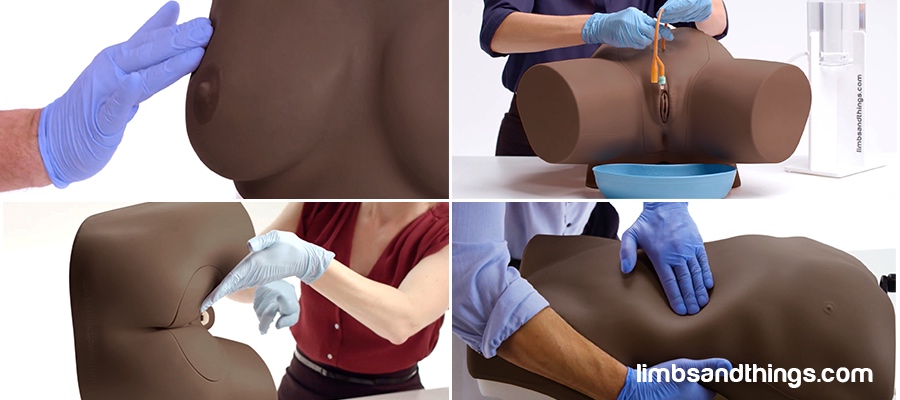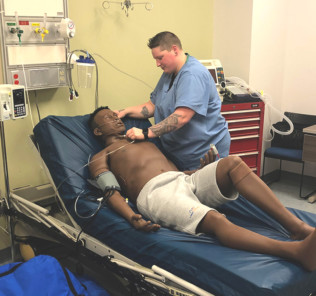Transcending Racial Disparity in Healthcare Simulation Education with Limbs & Things
There is a lot of discussion about diversity and cultural sensitivity in our world right now. For many years in healthcare we have encountered annual training that is meant to increase awareness about meeting the needs and concerns of any patient that we may encounter, regardless of age, skin tone, religion, gender, physical appearance, or socioeconomic status. Today, our friends from Limbs & Things wrote in to share some of the ways we can overcome racial disparity in healthcare simulation education through both leading research and realistic nursing skill task trainers which better represent minority communities.
Racial disparity in health care is not a new subject. One of the largest studies ever conducted on the topic in 1997 revealed that “blacks were significantly less likely than whites to receive a major therapeutic procedure in almost half of the 77 disease categories.”(1) Additionally, minority patients were “less likely to receive pain medication… technological monitoring, laboratory tests, and life-supporting treatments.”(1)
If you were to visit a simulation center in the past 10 years, you would find primarily light-skinned training models. Additionally, Simulated Patients (SPs) would not likely reflect the racial breakdown of the communities they serve, and scenarios would not likely be written to consider different presentations for the same diagnosis accounting for cultural differences.
Sponsored Content:
Now is the perfect time for faculty and simulation educators to build an inclusive culture into their curriculum. Annual training is not enough. Racial disparity must be considered for every scenario, every patient, every community, every time.
Research into diversity in simulation education shows that there is often a lack of diversity in not only simulation equipment, but also faculty members, students, and staff.(2) In a recent study on the lack of diversity in simulation technology, Conigliaro et. al state “if the intent is to expose learners to differing social backgrounds, facilitate understanding across cultural and racial divides, and, ultimately, challenge cultural stereotypes, attaining a diverse faculty and student body may be insufficient; achieving true appreciation and understanding of diversity may require that the educational environment is itself diverse.”(3)
Multicultural patients with many comorbidities are present in every town, every state, and every country. Bias is present, even though it may be unintentional, even in the education that is provided to our healthcare trainees.
In a recent study in Nursing Education Perspectives, authors Foronda et. al conducted an international study of simulation centers relating to racial diversity. Their results “demonstrated an underrepresentation of racial diversity in manikins, body parts/task trainers, standardized patients, and simulation facilitators.”(4)
Sponsored Content:
In his closing study remarks, Geiger states “the elimination of race/ethnicity-based and class-based disadvantage in the health sector has always been an unsteady march, rather than a seamless record of uninterrupted progress. The documentation and further exploration of disparity is a step in an ongoing journey.”(1)
To answer the call for increased diversity in simulation education, Limbs & Things has been working on widening their range of products available in both light and dark skin tones. They are hopeful that simulation centers can broaden their range of diversity offerings with affordable examination and procedural task trainers. This coupled with the ability to use their products as part of SP hybrid scenarios offers trainees the ability to add in communication that enhances health literacy for all patients.
Clinical Skills Task Trainers Available From Limbs & Things in Dark Skin Tones Now Include:
PROMPT Flex Standard
PROMPT Flex Advanced
PROMPT Flex – PPH Module
PROMPT Flex – Cervical Dilatation & Effacement
PROMPT Flex – Cesarean Section Module
PROMPT Flex – Postpartum Hemorrhage Kit
PROMPT Flex – Cervical Cerclage Module
Small ECOSystem with PROMPT Flex Advanced
Intermediate ECOSystem with PROMPT Flex Advanced
Large ECOSystem with PROMPT Flex Advanced
Perineal Repair Trainer
Mediolateral Perineal Repair Trainer
Midline Perineal Repair Trainer
Anal Sphincter Repair Trainer
Episiotomy Trainer
Advanced Venipuncture Arm
Standard Venipuncture Arm
Bag & Stand Advanced Venipuncture Arm
Clinical Female Pelvic Trainer (CFPT) Mk 3 – Standard
Clinical Female Pelvic Trainer (CFPT) Mk 3 – Advanced
Clinical Male Pelvic Trainer (CMPT) Mk 2 – Standard
Clinical Male Pelvic Trainer (CMPT) Mk 2 – Advanced
Male Rectal Examination Trainer – Standard
Male Rectal Examination Trainer – Advanced
Male Catheterization Trainer
Female Catheterization Trainer
Suprapubic Insertion (Ultrasound guided) Unit
Standard Catheterization Trainer Set
Advanced Catheterization Trainer Set
Standard Breast Examination Trainer
Advanced Breast Examination Trainer
Basic Breast Examination Trainer
Abdominal Examination Trainer
Abdominal Examination Trainer Value Set
Paracentesis Trainer
Chest Drain & Needle Decompression Trainer
Lumbar Puncture Model
Advanced Epidural & Lumbar Puncture Model
Ultrasound Epidural & Lumbar Puncture Model
Shoulder Injection Trainer – Palpation Guided
Shoulder Injection Trainer – Ultrasound Guided
Knee Aspiration & Injection Trainer with Ultrasound Capability
Visit the Limbs & Things Website to View These Task Trainers & More!
References:
- Institute of Medicine (US) Committee on Understanding and Eliminating Racial and Ethnic Disparities in Health Care; Smedley BD, Stith AY, Nelson AR, editors. Unequal Treatment: Confronting Racial and Ethnic Disparities in Health Care. Washington (DC): National Academies Press (US); 2003. Racial and Ethnic Disparities in Diagnosis and Treatment: A Review of the Evidence and a Consideration of Causes.
- Standards for Accreditation of Medical Education Programs Leading to the M.D. Degree.
- Conigliaro, Rosemarie L. MD; Peterson, Kerstin D. MA-TESL; Stratton, Terry D. PhD Lack of Diversity in Simulation Technology, Simulation in Healthcare: The Journal of the Society for Simulation in Healthcare: April 2020 – Volume 15 – Issue 2 – p 112-114.
- Foronda C, Prather SL, Baptiste D, Townsend-Chambers C, Mays L, Graham C. Underrepresentation of Racial Diversity in Simulation: An International Study. Nurs Educ Perspect. 2020;41(3):152-156.
Sponsored Content:















